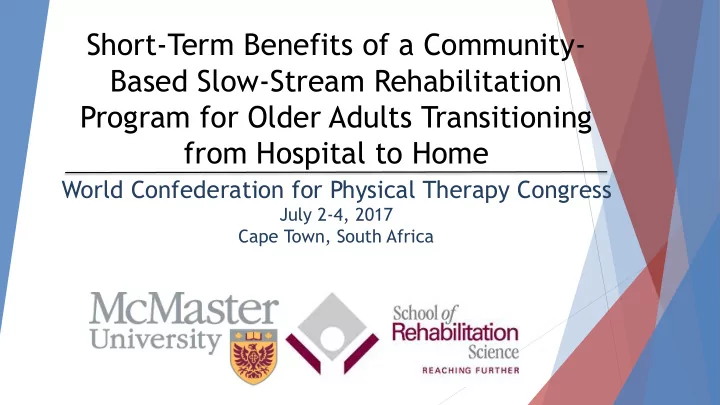

Short-Term Benefits of a Community- Based Slow-Stream Rehabilitation Program for Older Adults Transitioning from Hospital to Home World Confederation for Physical Therapy Congress July 2-4, 2017 Cape Town, South Africa
Team Members Vanina Dal Bello-Haas, PT, PhD Sirirat Seng-iad, PhD Principal Investigator Candidate Associate Professor Student Research Assistant Assistant Dean, Physiotherapy Program School of Rehabilitation School of Rehabilitation Science Science, McMaster University McMaster University Melody Maximos, MSc Sharon Kaasalainen, RN, PhD Candidate Co-Principal Investigator Student Research Assistant Associate Professor School of Rehabilitation School of Nursing Science, McMaster University McMaster University Olivia Virag Project Coordinator School of Rehabilitation Science, McMaster University July 2017
This research is possible through funding by the LaBarge Optimal Aging Initiative at McMaster University and the Saskatchewan Health Research Foundation Ethics approval from the Hamilton Integrated Research Ethics Board (HiREB # 15-089) July 2017
Background Limited health care and system resources and a focus on moving care to the community • much shorter hospital stays for older adults and discharge to home prior to full recovery (Kripalani 2014) Shortened hospital admissions for older adults and a corresponding increase in the use of post-acute services • community-based programs and adult day services have become important components in the older adult health care continuum. July 2017
Purpose ➢ The purpose of this mixed-methods study was to examine short-term physical function related effects and benefits of participating in Goldies2Home (G2H, Shalom Village, Hamilton, Ontario), a community- based, slow-stream rehabilitation program. July 2017
Methods ➢ Prospective, cohort study ➢ 64 participants • 62.5% females, mean age = 78.5 years (SD = 9.7) ➢ Participants completed a variety of tests and outcome measures at admission and discharge from G2H: • PHYSICAL: 6-minute Walk Test (6-MWT , endurance ), Mini-BesTest ( balance ), Rapid Assessment of Physical Activity (RAPA), Short Performance Physical Battery (SPPB, function ), Life Space Assessment (LSA, mobility ) • PSYCHOLOGICAL: Geriatric Anxiety Inventory (GAI), Geriatric Depression Scale (GDS), Montreal Cognitive Assessment (MoCA) July 2017
Analysis Descriptive statistics to describe the sample, one-sided paired t- test, confidence interval = 99% ➢ Evaluated change in outcome measures at discharge ➢ Parametric and non-parametric statistics Focus groups conducted at discharge ➢ Transcripts coded individually by two research team members and compared • Adjustments made to avoid personal bias and to reach consensus. • Disagreements were resolved via discussion with a 3rd team member • Codes were grouped, themes were developed and discussed with the team, and shared for additional triangulation July 2017
Results ➢ MOCA: mean score = 21.4 ( 5.5 ) ➢ 95.7% of participants were living with chronic conditions ➢ 47.8% lived alone ➢ 89.1% lived in a house, 10.9% lived in an assisted-living facility ➢ Average number of days in G2H program = 21.2 (SD = 3.6 ) ➢ Absence of clinically significant anxiety (GAI) and depression (GDS) scores at baseline and discharge July 2017
Results Admission Discharge Outcome Mean Mean Change p -value Measure (SD) (SD) 3.9 5.0 SPPB p ≤ 0.001 1.1* (2.6) (2.6) 128.9 m 173.8 m 6-MWT 44.9 m p ≤ 0.001 (84.4) (96.32) Mini- 7.3 8.9 p ≤ 0.001 1.6 BesTest (4.6) (5.4) 29.8 41.6 LSA p ≤ 0.001 11.8* (15.9) (21.3) *clinically meaningful July 2017
Results Significantly more participants engaged in physical activities at discharge, change in RAPA scores ( p = 0.001) Several positive aspects of the program were identified by participants related to services provided and outcomes Challenges that could be rectified to enhance participant experiences were also identified. “The only thing I want to say is that it is too short … I’m a little bit disappointed “ What we started not being able to do in the follow up …” (PFG 3) nothing, then ending up to be better at walking a little bit better, and have a little bit more strength ” (I16) “Less stress for the family, not so worried about him falling. He is more able to move around and he is stronger … He can now go “ The staff was most for walks with his wife again without accommodating ” (I17) anyone fearing for him” (CID018a) July 2017
Conclusions ➢ Mobility (LSA) and physical activity (RAPA) increased ➢ SPPB, Mini-BesTest scores were low and 6-MWT distances were limited both at baseline and discharge • Although SPPB scores were clinically and statistically significant, scores ≤ 6 are indicative of severe disability (Cruz-Jentoft 2010) • Mini-BesTest scores in Canadian older adults ( O’Hoski 2013) : • 70 to 79 years = 21; 80 to 89 years = 19.6 • ≤ 19 have identified recurrent fallers • Mean 6-MWT scores in community-dwelling older adults (Steffan 2002) • 70 to 79 years: males = 527 m, females = 471 m • 80 to 89 years: males = 417 m, females = 392 m July 2017 •
Implications ➢ Continued poor physical function following hospitalization places older adults at significant risk for adverse events: • rehospitalization; increased disability; institutionalization ➢ To what extent physical improvements are sufficient and can be sustained to maintain safe independent living post G2H discharge has yet to be determined ➢ Room for further improvement ➢ Despite short-term benefits and positive aspects of the G2H program, responding to challenges to enhance the model of care is warranted. July 2017
Acknowledgements We would like to thank and acknowledge our community partner, Shalom Village (Hamilton, Ontario) for their continued support and commitment to evaluating the Goldies2Home Program, and to all who have participated to date. July 2017
May 2016
Recommend
More recommend